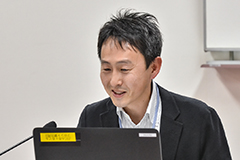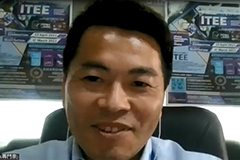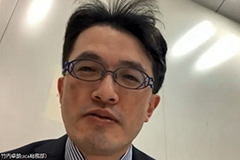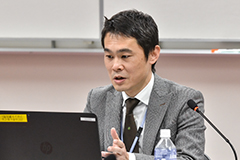Project History Book Launch: New ODA Approach Initiated in Bangladesh and Miyazaki
2022.06.27
On March 8, 2022, JICA Ogata Sadako Research Institute for Peace and Development (JICA Ogata Research Institute) held an online seminar to commemorate the publication of a Japanese book in the Project History series, “Regional Revitalization in Japan Brought About by Bangladeshi IT Personnel: A New Form of International Cooperation Connected From Volunteers to Industry, Government, and Academia” (provisional translation).
In his opening remarks, Director General Makino Koji of JICA Ogata Research Institute stated that “Official Development Assistance (ODA) is a ‘catalyst’ which builds bridges between people. In that sense, perhaps this case is one example of best practices at JICA.”
The author of this Project History book, Kano Tsuyoshi (currently an associate professor at Kanazawa Institute of Technology and the CEO and co-founder of ICT for Development Japan) then introduced stories from the book. He was responsible for a series of projects at JICA’s headquarters and Bangladesh office in his capacity as a JICA staff member. In the following panel discussion, speakers reflected on and commented on their experiences and achievements.
The setting for the project was 2008. Japan Overseas Cooperation Volunteers (JOCVs) with skills in computer technology, who had been active in Bangladesh, thought that if they could introduce the IT Engineers Examination (ITEE)—a Japanese test for information processing engineers which is mutually recognized by Asian countries—to Bangladesh, then young Bangladeshi people with prospects would be able to prove their competence and play active roles in their society. Shoji Akihiro (currently a JICA expert), who had started working to launch the movement as a JOCV at the time, recalled those days. “We JOCVs took a local viewpoint. While we were at a loss about what to do with our colleagues with no budget or power, we still struggled to spark innovation. We were lucky to have so many people willing to listen to us. The chief representative of the JICA Bangladesh Office created an opportunity for us to meet with the Bangladeshi Minister of Information and Broadcasting, and at our meeting, we performed a poem in which we said we wanted to form a great bridge between Japan and Bangladesh. There are poems known as ‘Kobita’ in Bangladesh, which have special meanings. Amazingly, the Minister gave an ode in reply, and our activities got off the ground,” he said. While involving many people, the activities of the JOCVs evolved into the introduction of ITEE and a JICA technical cooperation project to set up a system for the examination, and in 2014, Bangladesh was officially recognized as the seventh Asian country to conduct the ITEE.

Kano Tsuyoshi, the author of this Project History book, outlined the book

Shoji Akihiro recalled the days when he worked as a JOCV
In addition, the panel exchanged opinions about the “Project for Skills Development of ICT Engineers Targeting the Japanese Market,” a technical cooperation project which gave birth to the Miyazaki-Bangladesh Model that ran from 2017 to 2021. This model, which had the Japanese market in mind, offered Japanese language education programs for IT personnel and recruitment support to Bangladeshi youth. Miyazaki University would then accept these personnel, provide Japanese language education, and place them in IT companies in Miyazaki City with support from the city. Takeuchi Takuro (currently the Senior Director-General at JICA Headquarters), who was in charge of Bangladesh projects at the JICA South Asia Department at the time, said that “This was a project that could address the most serious problems of Bangladesh, which faces the challenge of creating employment opportunities for young people who have received higher education but lack the means for self-actualization, and Japan, which is suffering from a labor shortage. We were able to structure the project to turn out well because there were incentives for all stakeholders: the Bangladesh government, Miyazaki IT companies, Miyazaki City, Miyazaki University, and JICA, which brought them together.”

Takeuchi Takuro explained how the project can benefit both Japan and Bangladesh
In fact, of the 265 Bangladeshi graduates who participated in the project, 186 found employment in Japan. Notably, regarding the point that Miyazaki is second behind Tokyo in terms of taking in many workers from Bangladesh, Tasaka Shinnosuke (currently a program-specific professor at Miyazaki University), who was involved in the project as a JICA expert in a supervisory capacity, stated that “Miyazaki's strength is that industry, government, and academia work in tandem to create a structure for accepting Bangladeshi IT personnel, such as allowing them to take a three-month program at Miyazaki University which includes Japanese language study and internships at companies, rather than immediately having them come to Japan to work.” In terms of the lessons learned from this series of activities, Kano summed them up as: "First, it is vital to get people from the field, and then countries, to take action; second, we should create models in which each of the involved parties has incentives; and third, approaches which address the most important issues for Japan and developing countries simultaneously may lead to new ODA project designs in the future.”

Tasaka Shinnosuke explained the success factors behind the Miyazaki-Bangladesh Model
In the Q&A session, questions were raised about the challenges in matching the needs of the Japanese side with the needs of the Bangladeshi people, and about how the model could be expanded to other countries and regions. Finally, Yoshinari Yasue, director-general of the JICA Kyushu Center, brought the seminar to a close, saying “In order to achieve a multicultural and inclusive society, those on the Japanese side need to further compromise and improve communication by verbalizing Japan’s unique culture and values in a logical way, rather than just relying on the involved parties being on the same wavelength.”

事業事前評価表(地球規模課題対応国際科学技術協力(SATREPS)).国際協力機構 地球環境部 . 防災第一チーム. 1.案件名.国 名: フィリピン共和国.

事業事前評価表(地球規模課題対応国際科学技術協力(SATREPS)).国際協力機構 地球環境部 . 防災第一チーム. 1.案件名.国 名: フィリピン共和国.

事業事前評価表(地球規模課題対応国際科学技術協力(SATREPS)).国際協力機構 地球環境部 . 防災第一チーム. 1.案件名.国 名: フィリピン共和国.

事業事前評価表(地球規模課題対応国際科学技術協力(SATREPS)).国際協力機構 地球環境部 . 防災第一チーム. 1.案件名.国 名: フィリピン共和国.

事業事前評価表(地球規模課題対応国際科学技術協力(SATREPS)).国際協力機構 地球環境部 . 防災第一チーム. 1.案件名.国 名: フィリピン共和国.
scroll